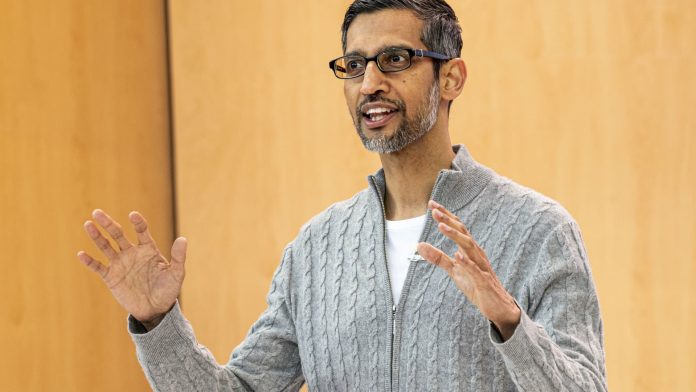[ad_1]
In the age of AI hype, few companies have used the word “AI” more than Google. Now, Wall Street wants know how it’ll turn the hyped tech into dollars and cents.
Google parent Alphabet reported its third quarter earnings Tuesday, which showed more spending on AI infrastructure and muted cloud growth, culminating into several questions for executives about how all the efforts around artificial intelligence are actually going to turn into real money.
For the third quarter, Alphabet reported revenue growth of 11%, returning to double digits for the first time in more than a year. However, its stock dropped in extended trading as cloud revenue disappointed.
Executives said capital expenditures in Q3 grew to $8 billion, driven “overwhelming” by AI compute and related technical infrastructure. However, many are wondering about what the return will look like as costs grow while executives repeatedly tout that it’s still “early days” for using advanced artificial intelligence.
The topic of how the company will monetize AI came up several times throughout Tuesday’s conference call’s question-and-answer portion with investors and analysts.
The questions come nearly a year after the public launch of ChatGPT last November, which set off a wave of hype around artificial intelligence technology. Google, seemingly caught off guard, sprung into action and has since released its own chatbot Bard, as well as various AI experiments across the company. Analysts and technologists have estimated that the critical process of training a large language model alone can be extremely costly — especially those with the largest data sets.
“As we just think about the rollout of SGE across a user base. Like, how far along is that? And how do you balance the product rollout and consumer uptake versus monetization in that transition?” Asked Lloyd Walmsley of Deutsche Bank.
“On the first part of our SG, we are still very early days in terms of how much we have rolled it out,” Pichai responded. “But we have definitely gotten it out to enough people and both geographically across user segments and enough to know that the product is working well.”
He added that the “true north” is getting the right user experience.
In August, Google launched an “early experiment” called Search Generative Experience, or SGE, which lets users see what a generative AI experience would look like when searching for products. The result is more conversational, reflecting the age of chatbots. However, it is still considered an experiment and has yet to launch to the general public.
Brian Nowak, managing director for Morgan Stanley, asked what signals investors can watch for when seeking a return on capital.
“I know it’s early, but are there any examples that you’re seeing with SGE or Bard on higher utility, higher conversion rates? More engagement? Just something to sort of show signal around the return that could come from these investments?” Nowak asked.
With SGE, Pichai said it’ll be able to include “a wider range of sources on the results page, creating new opportunities for content to be discovered.”
But some of Pichai’s responses were still pretty vague.
“Obviously, we see AI as a foundational platform shift and are excited about opportunities across our business. It starts with search,” Pichai answered. “And I’ve been pretty pleased with how the user feedback has been on SGE,” adding that it is generating value for its ecosystem of products.
Pichai added that with AI, he sees the opportunity to “evolve search and assistant for the next decade ahead.” He added, “I think as we have always seen when you continue to invest in both experiences, you can get value on the other side. And I do think over time there will be newer paths, just like we have done on YouTube.”
With YouTube, Pichai said AI is showing better performance and profitability for advertisers and giving them more help. For example, the company been working on AI-powered tools to allow advertisers to generate their own media assets and to suggest videos for YouTube creators, which CNBC first reported in May.
Chief Business Officer Philipp Schindler explained that the YouTube features let people create content in multiple languages and remix videos, adding, “we’re just getting started.”
Schindler also said the company expects AI to help businesses find “their ideal audience for the lowest possible price,” adding “early tests are delivering 54% more reach at 42% lower cost.” He said AI features are driving success for brands like Samsung and Toyota.
Noting advertising industry headwinds, UBS’s Eric Sheridan asked execs how AI will impact Google’s advertising goals and the industry overall in the coming years.
Pichai responded giving the example of Performance Max, Google’s new goal-based campaign type that allows performance advertisers to access all of their Google Ads inventory from a single campaign, which has recently been updated with AI features.
“It’s probably the ultimate example of AI,” Pichai said in response to Sheridan’s question. “Those using it achieve like an average over 18% more conversions at a similar cost per action.”
Pichai added that 80% of its advertisers already use at least one AI-powered search feature.
[ad_2]
Source link



